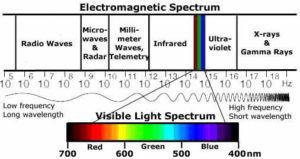Originally published November 2007
People with macular degeneration gradually lose their color perception. This is because the photoreceptor cone cells, which are most dense in the macula, are responsible for color vision. The rod cells, which proliferate in the peripheral field, provide only black and shades of gray.
Color is interpreted by the brain. The color it interprets depends upon the signals sent by the cone cells. When the cones, however, are weakened by disease, they lose their sensitivity to the lower-intensity wavelengths and are unable to send proper signals. Blue, green, and red (called spectral colors) are the easiest to see. Other (non-spectral) colors are created by overlapping of the spectral wavelengths at various intensities (levels of brightness).

The Visible Light Spectrum
In normal eyes, the photoreceptor cone cells are divided fairly equally into three sets. One set contains a molecular pigment called cyanolabe, which makes the cones sensitive to light waves centering around 425nm (nanometers) in length. A second set contains the pigment chlorolabe, which centers around 525nm, and a third set contains erythrolabe, which centers around 625nm. When these sets of cells are stimulated by light, the corresponding pigment molecules release electrons that are picked up by the retinal neurons and sent to the brain. The brain interprets those wavelengths as the so-called spectral colors blue, green, and red, respectively. All other colors are combinations of the spectral colors at various intensities. (Violet is also a spectral color, but it is so close to the low end of the visible light spectrum as to appear almost black.)
Weakened cone cells first lose their sensitivity to the lower- intensity wavelengths, such as yellow, purple, and pastels. When this happens, the brain will see only black and shades of grey. Cones can be weakened permanently by disease, or they can be temporarily disabled (even in normal eyes) by overexposure to light. The weaker the cells become due to disease, the longer they will take to recover and the less sensitive they become. Eventually, all color perception is lost.
Loss of color perception from macular degeneration and color blindness are not the same. Color blindness is caused by an altered gene causing a cone cell to lack the proper molecular pigment. The cell is healthy in all other respects. Loss of color perception due to macular degeneration is the result of a normally-formed cell losing its ability to function. Cures do not yet exist for either condition.
(Principal source: http://library.thinkquest.org/28030/physio/colour.htm)